Title: Beyond Stablecoins: The Case for Ethereum
Source: Electric Capital, compiled by AIMan@黄金财经
Key Points
Rather than falling, global demand for the U.S. dollar has exploded. Although news headlines focus on "de-dollarization," a more important trend is emerging: more than 4 billion people and millions of businesses are actively seeking to obtain dollars through stablecoins, representing the largest expansion of the U.S. dollar network effect in decades.
This creates unprecedented opportunities for Ethereum. Stablecoins provide access to dollars for individuals around the world - with a 60-fold increase to over $200 billion since 2020 - millions of new dollar holders need more than just digital cash. They need yield, investment opportunities, and financial services. Traditional finance cannot serve this massive new market due to regulatory and infrastructure constraints.
Ethereum is uniquely positioned to provide global financial infrastructure for this new digital dollar economy, and ETH will directly benefit from this growth.
1. Millions of new dollar holders enter the dollar market through stablecoins
There is huge potential demand for dollars from individuals and businesses around the world.
People around the world want to use dollars for security:
More than 4 billion people face huge currency risks due to political instability, poor monetary policy, and structural inflation.
An estimated 21% of the world’s population lives in countries with annual inflation rates exceeding 6%, rapidly eroding savings and purchasing power.
For these populations, holding US dollars means financial security. The dollar is seen as a store of value, a means of transacting across borders, and a hedge against fluctuations in local currencies.
Businesses need dollars to conduct transactions:
The dollar remains the dominant currency for global trade, with 88% of global foreign exchange transactions involving at least one party in the U.S. dollar.
Businesses in emerging markets rely on dollar liquidity for international payments, imports, and supply chains, where local banking and foreign exchange markets are often limited or unstable.
SMEs and freelancers increasingly need digital dollars to get paid and avoid currency mismatch risk.
For the first time in history, anyone in the world can hold USD through stablecoins:
Anyone with internet access can hold and trade USD — no banks, no government permission, available 24/7 worldwide.
As a result, stablecoin market capitalization has increased 60x since 2020.
Major adoption has been concentrated in emerging markets that were previously excluded from USD-denominated finance. Nigeria has become the world’s second-largest cryptocurrency market, while underground cryptocurrency adoption continues in China under a ban.
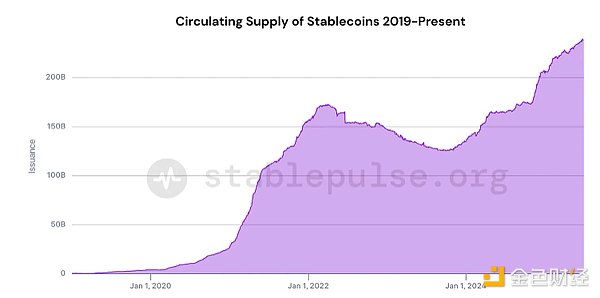
Stablecoins are creating a new group of dollar holders among the world's largest population groups - businesses pricing in USDT and households saving in USDC. They are driving a fundamental expansion of the dollar financial services market.
2. These new dollar holders seek yield, creating opportunities for a new global financial infrastructure
Stablecoin holders want to put their money to work.
Today, millions of people can hold dollars through stablecoins. But their desires go far beyond that. Individuals and businesses naturally want to use their money to earn yield, invest, and grow wealth.
Traditional finance cannot serve this new market:
The U.S. banking system requires regulatory compliance that excludes most global players.
Cross-border financial services remain expensive, slow, and geographically limited.
Traditional finance was built for institutions and high net worth individuals, not global retail.
Geographic and regulatory barriers prevent billions from participating in dollar-denominated financing.
This creates a need for new financial infrastructure that can serve the billions of stablecoin holders around the world, allowing them to put their new dollars to work.
3. Only if Ethereum meets all three requirements can it serve global stablecoin holders
The new financial infrastructure that serves stablecoin holders must meet three key requirements at the same time:
Globally accessible - must be available everywhere there is internet access, from New York to Nigeria to rural Nepal. Most of the world cannot access dollar-based financing due to geographic or regulatory reasons.
Secure for institutions - must provide the security, reliability, regulatory clarity, and customizability that institutions need to build financial products worth billions of dollars.
Resistant to government intervention - must not be controlled by any single government, as many governments prefer to restrict the circulation of dollars to protect local currencies and control capital flows.
Ethereum meets all three requirements:
Globally accessible: Ethereum is available 24/7 to anyone with an internet connection around the world.
Safe for institutions:
Secure - The most economically secure and decentralized of all programmable blockchains. Most mature security infrastructure - The largest number of open source developers, verified contracts, security audit developers, and tools.
Reliable - 100% uptime for 10 years, regardless of market crashes or geopolitical events.
Regulatory compliant - U.S. regulators have classified ETH as a commodity, providing a clear institutional framework.
Customizable — Ethereum’s L1+L2 framework enables customizability, allowing institutions to optimize for specific use cases and meet regulatory requirements (e.g., Coinbase and Robinhood have both built L2 chains on Ethereum).
Excellent track record — Owns the world’s largest digital financial economy: over $140 billion in stablecoins, over $60 billion in decentralized finance (DeFi) protocol investments, and over $7 billion worth of real-world asset tokenization.
Resistant to government intervention: There is no single point of control that governments can seize to control or restrict the network.
Ethereum uniquely meets these requirements with its strong decentralization — its origin story is almost impossible to replicate today.
Strong decentralization makes Ethereum globally accessible, secure, reliable, and resistant to government intervention.
This level of decentralization is rooted in Ethereum’s origins and culture.
Ethereum began as a community-funded, proof-of-work blockchain, which made asset ownership very broad. But today’s environment makes it no longer suitable to launch in this way.
Its culture has always prioritized decentralization—maintaining expensive customer diversity and resisting centralized shortcuts—and this culture is almost impossible to transform.
As a result, Ethereum has decentralized advantages that other public chains cannot easily replicate, which also provides Ethereum with a lasting moat.
1 million+ validators in over 100 countries
Multiple independent development teams ensure resilience and the largest open source developer ecosystem
Wide asset ownership due to community-funded launch and proof-of-work origin
No other alternative meets all three requirements at once:
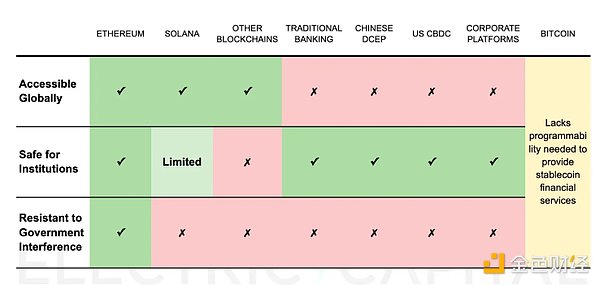
* Bitcoin may become more programmable in the future, but only if the Bitcoin community agrees to change the opcode to enable this functionality.
4. As ETH becomes a reserve asset for the new digital dollar economy, its demand may increase
What is a reserve asset?
In any financial system, reserve assets are the trusted base layer that supports everything. It is the collateral, savings or liquid assets held by institutions, protocols and users for value storage, loan guarantee and transaction settlement.
In the traditional system, the US dollar, US Treasury bonds and gold are examples of reserve assets because they are trustworthy, liquid and widely accepted.
Why ETH naturally plays this role
With billions of dollars flowing through stablecoins on Ethereum, participants need a secure, permissionless and efficient asset to support lending, staking and yield generation. ETH is uniquely positioned in this regard because:
Scarce and Trusted: ETH has a predictable supply, low inflation, and is not centrally controlled.
Interest-Bearing: Unlike gold or static dollars, ETH generates yield through staking — similar to how you generate income when holding real estate or treasury bonds.
Collateral Utility: ETH is already the largest on-chain collateral asset in the Ethereum ecosystem, backing $19 billion worth of lending protocols. Institutions hold it because they need it to enter the DeFi market.
Seizure and Censorship Resistance: ETH cannot be frozen or seized by governments, making it more resilient than centrally issued assets.
Programmable and Liquid: ETH is deeply integrated into the entire on-chain financial system and has unparalleled liquidity for large transactions.
Why this makes ETH valuable
As more users hold stablecoins and need financial services, they need a reserve asset to support these activities. ETH can earn yield, provide network security, and support DeFi lending - so as the system grows, the demand for ETH will naturally grow.
Simply put: more stablecoin adoption → more on-chain activity → more demand for ETH as collateral → institutions and users hold more ETH.
L2s expand demand for ETH
The growth of Ethereum Layer-2 further stimulates demand for ETH. By reducing transaction costs, speeding up transactions, and enabling new use cases, Layer-2 opens up more areas where ETH can be used as collateral. This expands ETH's reach and strengthens its position as a reserve asset for the digital dollar economy.
5. As demand for ETH increases, it is also expected to become a global store of value
The growing demand for ETH has also enabled it to occupy a large share of the traditional value storage market.
Like Bitcoin, Ethereum has superior value storage (SoV) properties than traditional assets such as gold.
ETH and BTC will not compete with each other, but may take a share of the $500 trillion worth of traditional SoV assets (gold, treasuries, stocks, real estate) in the next few years.
In addition to Bitcoin's SoV properties, ETH also provides income to holders.
Generating income is a big plus because investors generally favor income-generating assets. American households hold about $32 trillion in dividend-paying stocks, while they hold less than $1 trillion worth of gold.
ETH has superior characteristics to traditional SoV assets and can provide returns:
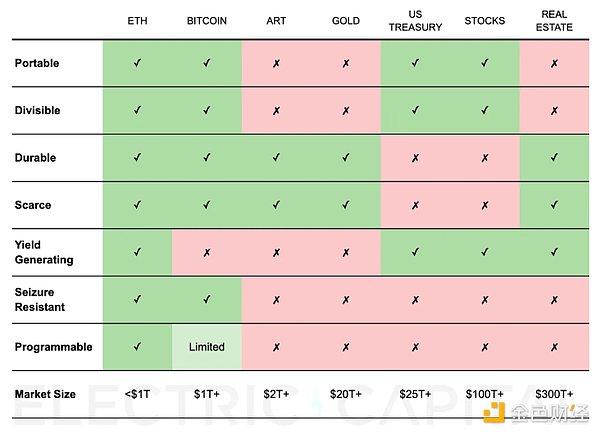
6. Conclusion: Holding ETH may be the best way to participate in the growing stablecoin economy
The growth of the stablecoin economy has established a powerful flywheel for Ethereum and ETH.
As more and more stablecoins are put into use on Ethereum, the demand for ETH has also increased. Higher ETH value and a more secure network have attracted more institutions and services, further promoting the popularity of stablecoins.

Alternatives face significant challenges in replicating this flywheel:
Traditional finance fails to serve the billions of people excluded by geographic and regulatory barriers.
Government-controlled systems remain subject to political influence and jurisdictional limitations.
Bitcoin lacks the programmability for complex financial services.
Other blockchains lack the security, reliability, and customizability that institutions need, and lack the decentralization that resists government intervention.
The upshot: Holding ETH may be the simplest and most efficient way to gain exposure to the growing stablecoin economy.
You can also choose to invest in specific DeFi protocols that benefit from the expansion of stablecoins. But this is riskier and requires expertise.
For most retail and institutional participants, ETH offers the simplest exposure to the entire digital dollar ecosystem.
Appendix
Risks to Watch
Like any emerging global system, Ethereum faces significant risks. While there are many risks, three of them pose the greatest threat to the thesis that Ethereum will build a permissionless, dollar-based financial system with ETH as a reserve asset.
1. The US dollar becomes a reserve asset, not ETH
If stablecoins like USDC or USDT dominate and are used for lending, collateralization, and settlement, the US dollar may replace ETH as the reserve asset of the system. In this case, ETH may be seen as primarily "gas money" rather than a core means of storing value. However, given that ETH accounts for 44% of on-chain lending collateral on the Ethereum mainnet and Layer2 and generates a 3-5% staking yield, replacing ETH seems challenging. More importantly, ETH is the only truly decentralized asset on Ethereum - stablecoins like USDC and USDT are centralized and can be frozen or seized, making them fundamentally unable to perform ETH's duties as censorship-resistant collateral. More likely, ETH and the US dollar will play complementary roles - the US dollar is committed to stability and transaction optimization, while ETH provides decentralized, anti-seizure value storage and network ownership.
2. Competition from CBDCs, replacing the adoption of USD stablecoins
Central bank digital currencies (CBDCs) can provide similar 24/7 access to digital dollars with full sovereign backing, which could crowd out private stablecoins and limit the permissionless USD system currently supported by Ethereum. CBDCs are national in nature, often lack true cross-border interoperability, and may limit open developer access due to compliance and identity requirements. In contrast, stablecoins have settled trillions of dollars each year, operate globally by default, and maintain greater flexibility in innovation, making it difficult for CBDCs to replace them.
3. Competitive chains surpass Ethereum
A faster, lower-cost, and less initially decentralized blockchain may be able to attract users and developers who value low fees and a simple user experience, and create strong liquidity and network effects in the early stages. Over time, this chain may be able to mature its validator set sufficiently to reach a level of “sufficient decentralization” to disintegrate Ethereum’s dominance. However, given Ethereum’s level of decentralization and more than a decade of proven security, it will not be easy to replace it.
Additional Data
Annual stablecoin settlement volume exceeds $6 trillion (10x increase from 2020):
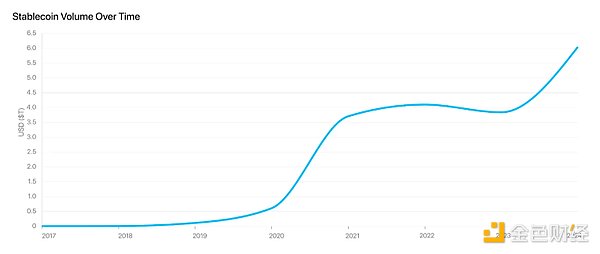 Ethereum owns more than 55% of stablecoins:
Ethereum owns more than 55% of stablecoins:
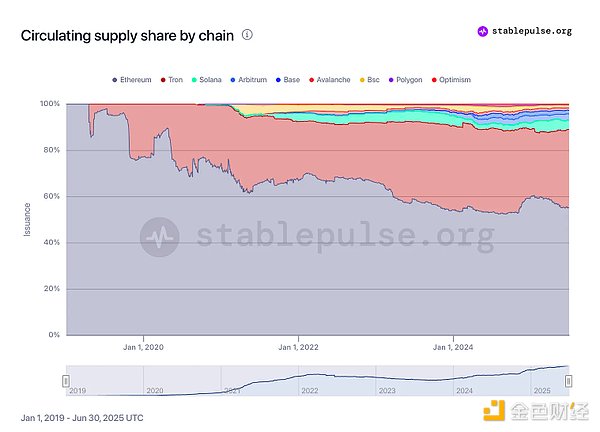 ETH may become the reserve asset of the new financial system. 44% of lending collateral in the Ethereum ecosystem is in ETH, making it the largest collateral asset ($19 billion):
ETH may become the reserve asset of the new financial system. 44% of lending collateral in the Ethereum ecosystem is in ETH, making it the largest collateral asset ($19 billion):
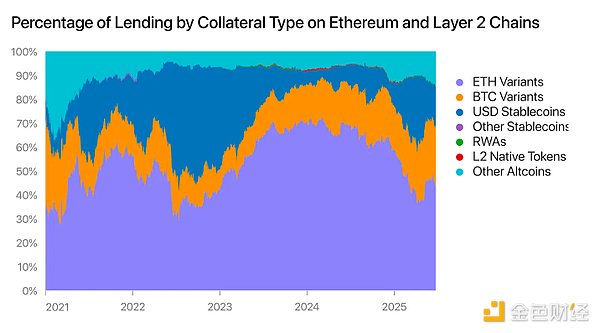
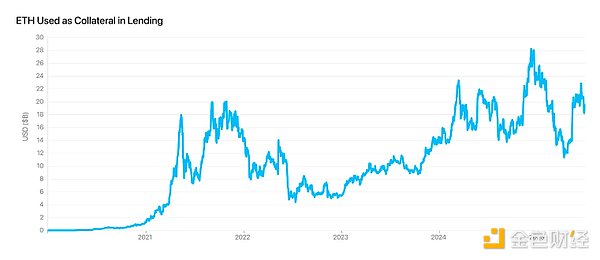
 Weatherly
Weatherly





 Ethereum owns more than 55% of stablecoins:
Ethereum owns more than 55% of stablecoins: ETH may become the reserve asset of the new financial system. 44% of lending collateral in the Ethereum ecosystem is in ETH, making it the largest collateral asset ($19 billion):
ETH may become the reserve asset of the new financial system. 44% of lending collateral in the Ethereum ecosystem is in ETH, making it the largest collateral asset ($19 billion):



